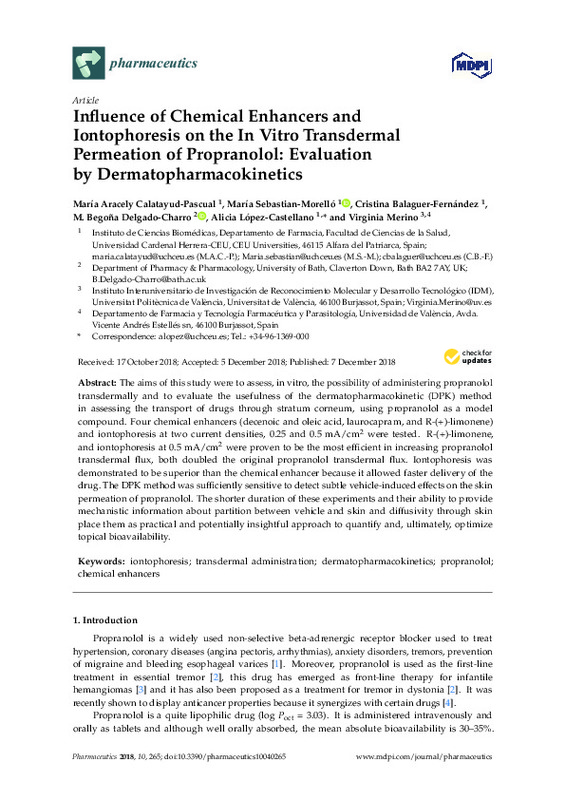JavaScript is disabled for your browser. Some features of this site may not work without it.
Buscar en RiuNet
Listar
Mi cuenta
Estadísticas
Ayuda RiuNet
Admin. UPV
Influence of Chemical Enhancers and Iontophoresis on the In Vitro Transdermal Permeation of Propranolol: Evaluation by Dermatopharmacokinetics
Mostrar el registro sencillo del ítem
Ficheros en el ítem
| dc.contributor.author | Calatayud-Pascual, M.A.
|
es_ES |
| dc.contributor.author | Sebastian-Morelló, M.
|
es_ES |
| dc.contributor.author | Balaguer-Fernandez, C.
|
es_ES |
| dc.contributor.author | Delgado-Charro, M.B.
|
es_ES |
| dc.contributor.author | Lopez-Castellano, A.
|
es_ES |
| dc.contributor.author | Merino Sanjuán, Virginia
|
es_ES |
| dc.date.accessioned | 2020-07-04T03:32:03Z | |
| dc.date.available | 2020-07-04T03:32:03Z | |
| dc.date.issued | 2018-12-07 | es_ES |
| dc.identifier.uri | http://hdl.handle.net/10251/147428 | |
| dc.description.abstract | [EN] The aims of this study were to assess, in vitro, the possibility of administering propranolol transdermally and to evaluate the usefulness of the dermatopharmacokinetic (DPK) method in assessing the transport of drugs through stratum corneum, using propranolol as a model compound. Four chemical enhancers (decenoic and oleic acid, laurocapram, and R-(+)-limonene) and iontophoresis at two current densities, 0.25 and 0.5 mA/cm(2) were tested. R-(+)-limonene, and iontophoresis at 0.5 mA/cm(2) were proven to be the most efficient in increasing propranolol transdermal flux, both doubled the original propranolol transdermal flux. Iontophoresis was demonstrated to be superior than the chemical enhancer because it allowed faster delivery of the drug. The DPK method was sufficiently sensitive to detect subtle vehicle-induced effects on the skin permeation of propranolol. The shorter duration of these experiments and their ability to provide mechanistic information about partition between vehicle and skin and diffusivity through skin place them as practical and potentially insightful approach to quantify and, ultimately, optimize topical bioavailability. | es_ES |
| dc.description.sponsorship | This research was funded by Ministerio de Ciencia e Innovación (AP2007-03456) and the Universidad CEU Cardenal Herrera. | es_ES |
| dc.language | Inglés | es_ES |
| dc.publisher | MDPI AG | es_ES |
| dc.relation.ispartof | Pharmaceutics | es_ES |
| dc.rights | Reconocimiento (by) | es_ES |
| dc.subject | Iontophoresis | es_ES |
| dc.subject | Transdermal administration | es_ES |
| dc.subject | Dermatopharmacokinetics | es_ES |
| dc.subject | Propranolol | es_ES |
| dc.subject | Chemical enhancers | es_ES |
| dc.title | Influence of Chemical Enhancers and Iontophoresis on the In Vitro Transdermal Permeation of Propranolol: Evaluation by Dermatopharmacokinetics | es_ES |
| dc.type | Artículo | es_ES |
| dc.identifier.doi | 10.3390/pharmaceutics10040265 | es_ES |
| dc.relation.projectID | info:eu-repo/grantAgreement/MEC//AP2007-03456/ES/AP2007-03456/ | es_ES |
| dc.rights.accessRights | Abierto | es_ES |
| dc.description.bibliographicCitation | Calatayud-Pascual, M.; Sebastian-Morelló, M.; Balaguer-Fernandez, C.; Delgado-Charro, M.; Lopez-Castellano, A.; Merino Sanjuán, V. (2018). Influence of Chemical Enhancers and Iontophoresis on the In Vitro Transdermal Permeation of Propranolol: Evaluation by Dermatopharmacokinetics. Pharmaceutics. 10(4):1-15. https://doi.org/10.3390/pharmaceutics10040265 | es_ES |
| dc.description.accrualMethod | S | es_ES |
| dc.relation.publisherversion | https://doi.org/10.3390/pharmaceutics10040265 | es_ES |
| dc.description.upvformatpinicio | 1 | es_ES |
| dc.description.upvformatpfin | 15 | es_ES |
| dc.type.version | info:eu-repo/semantics/publishedVersion | es_ES |
| dc.description.volume | 10 | es_ES |
| dc.description.issue | 4 | es_ES |
| dc.identifier.eissn | 1999-4923 | es_ES |
| dc.identifier.pmid | 30544534 | es_ES |
| dc.identifier.pmcid | PMC6321337 | es_ES |
| dc.relation.pasarela | S\383214 | es_ES |
| dc.contributor.funder | Universidad CEU Cardenal Herrera | es_ES |
| dc.contributor.funder | Ministerio de Educación y Ciencia | es_ES |








